Article Contributed by Gratefulweb
Published on May 3, 2008
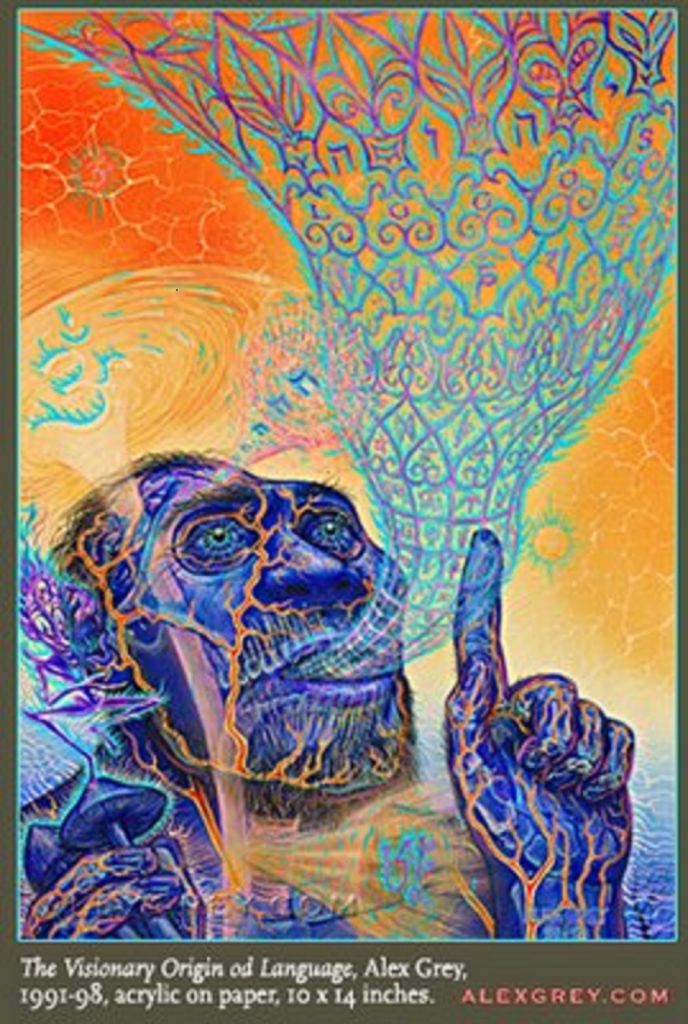
Alex Grey is an artist specializing in spiritual and psychedelic art (or visionary art) that is sometimes associated with the New Age movement. Alex Grey is a Vajrayana practitioner. His oeuvre spans a variety of forms including performance art, process art, installation art, sculpture, and painting. Grey is a member of the Integral Institute. He is also on the board of advisors for the Center for Cognitive Liberty and Ethics, and is the Chair of Wisdom University’s Sacred Art Department. He and his wife Allyson Grey are the co-founders of the Chapel of Sacred Mirrors, aka CoSM, a non-profit institution supporting Visionary Culture in New York City.
Grey’s paintings have been featured in venues as diverse as the album art of Tool, SCI, the Beastie Boys and Nirvana, Newsweek magazine, the Discovery Channel, Rave flyers and sheets of blotter acid. His work has been exhibited worldwide, including Feature Inc., Tibet House, Stux Gallery, P.S. 1, The Outsider Art Fair and the New Museum in NYC, the Grand Palais in Paris, the Sao Paulo Biennial in Brazil. Alex has been a keynote speaker at conferences all over the world including Tokyo, Amsterdam, Basel, Barcelona and Manaus. The international psychedelic community has embraced Grey as an important mapmaker and spokesman for the visionary realm.
GW: Alex, can you recall your years as an art student? Also, at what point were you first interested in visionary art?
AG: As an art student I was a nihilist existentialist. I dropped out of art school after two years and went to work for Columbus Outdoor Advertising to paint billboards. I sent invitations to the openings of the new boards I painted, calling the work Capitalist Realism, making them part of the conceptual art movement of the 70’s. Then I moved east and attended art school again for a year, studying conceptual and performance art.
Focusing on an examination of polarities such as life and death, I observed and documented a dead dog rotting. Later that year, observing the intuitive and the rational hemispheres of the brain, I shaved off half of my hair. Six months later, I shaved off the other half in a ritual performance. Placing the shaved hair on a human brain, I ate spaghetti, took the universal antidote, syrup of ipecac, and vomited onto the brain and hair. I wrapped the entire mess in a bag and called the performance “Brain Sack”. These acts tapped into a deeply disturbed but somewhat shamanic search for meaning.
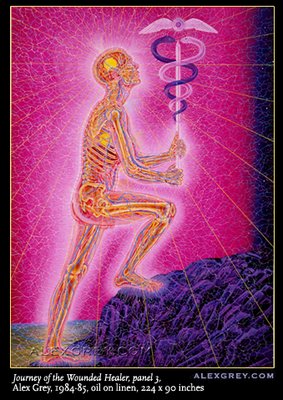
My study of polarities led me to trek to the North Magnetic Pole to perform “Polar Wandering”. I found it ironic that the force humanity relies upon to get its bearings, the site to which all compasses point, is continually in motion, a phenomenon by that name. Returning, I asked God to give a sign because I felt desperately in need of spirit. Within 24 hours of that supplication I took LSD and experienced the unity of polarities as well as having met my wife, the human embodiment of divine love in my life. LSD was my first “visioning.”
After “Polar Wandering”, I left art school for good and took a job in a medical school morgue where I prepared bodies for dissection. A student of the subject of consciousness, I felt it was imperative to study the container in which consciousness lives.
GW: You are considered by many to be a master of visionary art. As you know, visionary art is often not accepted by what you have called the “legitimate” art world. In your opinion, why has visionary art struggled?
AG: Considering Modernism and Post-Modernism, the importance of Mystic and Visionary states of consciousness have been downplayed or ignored by most artists, critics and curators. Picasso’s Cubism flattened the world into broken surfaces and shadows, with very little spiritual elevation. Pollock’s chaotic compositions reflect further fragmentation of self, a loss of center, continuing the existential crisis of Modernism. Pop art is a perfect mirror of our shallow, surface-oriented materialist corporate culture. Most recent art that includes religious imagery profanes the sacred (Serrano, Warhol, Gober) or if there are spiritual intentions behind the work, it’s appearance is ambiguous (Rothko, Agnes Martin, Turrell).
When art devalues the self and the authenticity of the inner worlds we get art of the absent self, the hollow and shattered self, a hopeless self, in short, the art of today. Outsider Art is one cultural venue where visionary states are considered relevant, but often “Outsider” artists are considered naive or pathological. Humanity needs art that helps us reclaim the sacred experience of life, so that we will take actions that favor our species’ long term survival.
GW: At the same time… the history of visionary art can be traced back to the dawn of man. The roots of what we call visionary art today is deeply embedded throughout the span of art history, correct?
AG: There is a strong global visionary tradition. Visionary art has existed and continues to exist in every culture from pre-historic to contemporary times. I write about the tradition of visionary art extensively in my book The Mission of Art and speak of it also on the audio cassette The Visionary Artist (SoundsTrue). The 16,000-year old cave paintings of human/animal hybrids, such as the “Sorcerer of Trois Freres,” are a good starting point. Ancient shamanic art, such as African ritual masks or Aboriginal rock and bark painting, clearly depict visionary dream-time wanderings and encounters in the lower and upper spirit worlds.
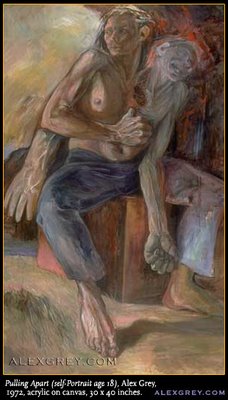
One of the earliest known Western mystic visionary artists was Hildegard of Bingen, a 12th-century German nun. Icons created from her visions are direct gifts of spirit. The 15th-century painter Hieronymus Bosch’s “Garden of Delights” is one of the strangest paintings in the world – an encyclopedia of metamorphic plant/animal/human symbolism. Pieter Brueghel was touched with the same visionary madness. Renaissance artists like Grunewald, Durer and Michelangelo delineated the spirit of Christian mysticism and Gothic realism.
Seventeen-century alchemical engravings detail complex philosophical mandalas pointing to union with the divine. William Blake, the 18th/19th-century mystic artist and poet, conversed with angels and received painting instructions from discarnate entities. Blake’s work laid the foundations for the 19th-century symbolist and 20th century surrealist and fantastic realist movements in art. In other words, there is a strong foundation of visionary art to be found throughout the span of art history. It is hard to deny that connection, but people often do.
GW: Speaking of art history… some of your imagery is reminiscent of past artists – Hieronymus Bosch for example. Can you discuss some of your influences? Tell us about your specific roots…
AG: My father was my first influence and I consider him to be the most important teacher I ever had. He was an artist and he encouraged my early drawing. My father guided my development until I became a rebellious teenager. During my teenage years I grew very fond of Michelangelo’s art. His Neo-Platonic idealism combined with gothic Catholicism is very tripped out. I would have to say that Michelangelo’s obsession with the struggle of body and soul is something that I can relate to in my own work. Other influences would include Blake, Rembrandt, Van Gogh, Tibetan and Hindu Tantric art, Ernst Fuchs, Jackson Pollock, Jean Delville, Pavel Tchelitchew and especially my wife Allyson Grey.
GW: What would you say to people who do not have knowledge about visionary art? How would you describe a work of visionary art to them? How would you introduce them to your art?
AG: A work of visionary art can shock a person out of their normal thinking patterns, and help them to see the world in a new way, help them to transfigure their perception of reality. Obviously, it’s only one of many potential catalysts to healing and transformation, but I think it can be a significant one. It is as if the artist reveals his or her soul’s journey through art and leaves the door open for viewers to find their own path.
As for my work, it is about the direct reproduction of intense visions. One’s memory gets etched by the “naturally occurring” or the “psychedelic” visionary experience and there is something you don’t understand about them, something profoundly disorienting but important in them. My goal is to bring back the state of wonder and amazement as directly as possible. That way, the contemplative viewer can resonate with it and it might reinforce an experience that has meaning for them.
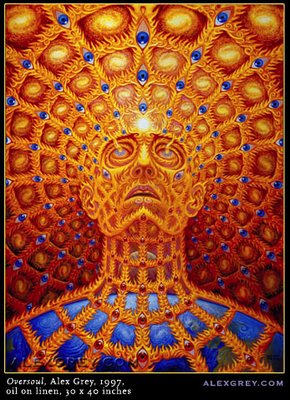
My work examines the nature of consciousness, life, human identity and relationships through various mediums and imagery. I paint representations of the physical body and interlace the subtle vital and psychical energy systems from both eastern and western occult mystical and medical traditions, the acupuncture meridians and points, the chakra systems, halos, etc. I take a multicultural and multidimensional perspective in order to get as many truths as possible into my vision of our divine nature.
GW: There has been some controversy over your work through the years – specifically your use of drugs as a means of exploration. As you know, the United States has taken a hard line against drug use. What are your thoughts on this issue?
AG: I am not an advocate of indiscriminate drug-taking, by any means. However, when I am asked to comment on the source of my own personal inspiration it would be hypocritical not to discuss my entheogenic experiences.
A Johns Hopkins medical study, reported in Psychopharmacology Journal (2006), has proven scientifically that psilocybin can enable people to have full blown life transforming mystical experiences. Because the mystical experience is the foundation of all world religions, the United States government is interfering with people’s freedom to practice religion by criminalizing the use of these sacraments. I am a stand for cognitive liberty, the right to alter consciousness anyway one sees fit, as long as the user causes no harm to anyone else. This is a right that requires a mighty sense of responsibility. Some people are allergic to peanuts and could die if they eat them. Peanuts should not be outlawed and are not safe for everyone.
An artist does not have to experiment with drugs to create visionary art but must experience the visionary state. Adult artists who are interested in this type of exploration, should consider an appropriate set and setting to enhance the sacred dimensions of one’s consciousness. Young people should not take drugs. They should be forming their identity and strengthening their ego, not dissolving it prematurely.
GW: What about the dangers of using drugs to explore yourself and the beyond? Do you have concerns about that?
AG: A person could poison themselves and die from drinking alcohol all day. Smoking marijuana day and night for a week would not kill you. Alcohol is legal but it is far more toxic than marijuana. Corporations decide which drugs are forbidden and which are promoted. There is no known toxic dose of LSD and used in a therapeutic setting it has the ability to relieve people from addiction to alcohol. Ibogaine can alleviate an addiction to heroine in one session. Psychoactive drugs need to be studied and safer inebriants such as marijuana, should be legal.
GW: Can you talk about the influence that drugs have had on visionary art and art in general? You mentioned the sixties earlier…
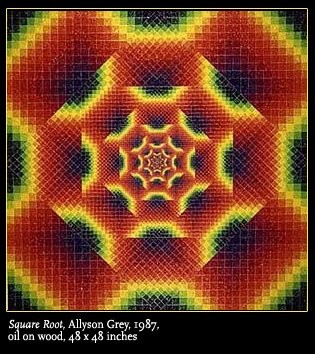
AG: The psychedelic ’60s spawned a new approach and style to all the arts including clothing design, graphic design, music, film, painting and sculpture. Psychedelics influenced every aspect of visual life. Ernst Fuchs and Mati Klarwein are two of the greatest painters that came to prominence from that era and both were obviously influenced by psychedelics. In the 70’s, dystopic visions of contemporary hell-worlds were stunningly portrayed in the works of H.R. Giger, famous for his work on the movie, “Alien.” Keith Haring, one of the most powerful artists of the 80’s credited LSD as the inspiring source of his style. What unites these artists is their unconventionally intense imaginations and their capacity to reveal the full spectrum of the vast visionary dimensions of the mind, the heavens and the hells.
GW: Alex, can you talk about some of the symbolism behind your work… the eyes for example?
AG: The eye is the lens through which we see and through which we recognize others. It is the focus of awareness. The eye is the window to the soul, an outer manifestation of awareness in the deepest sense. A multiplication of eyes signifies expanded or increased awareness. An infinite field of eyes represents infinite. awareness.
GW: What about the spiritual side of your art?
AG: Art can be a spiritual practice, enabling the practitioner to develop qualities of mental clarity, mindfulness of the moment, wisdom, compassion and access to revelations of higher mystic states of awareness. A contemplative method, such as yoga or meditation, will stabilize and assist in the progress of spiritual awareness. An artist’s craft can become a contemplative method, and the creations may provide outward signs of an inner spiritual journey.
Art is a covenant relationship between spirit, the artist and the viewer. The artist, if he or she has an inspiring spiritual experience, has a responsibility to translate and transmit that experience as closely as possible so as to evoke a similar experience in the viewer.
GW: Does the use of drugs help you – and others – to find the spiritual in art?
AG: Many people have told me that they experienced my artwork for the first time while taking their first acid trip. They tell me that it helped them to have a spiritual opening. Not everyone that uses drugs has a religious experience. However, many report a sense of unbounded compassion for others and themselves during an Ecstasy, or LSD, or mushroom experience.
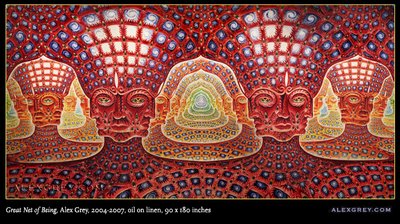
During a trip, the typical boundaries of our identity dissolve and one may be able to experience their unity with all dimensions of reality simultaneously. It can be overwhelming, but it can also be a guidepost and affirmation of the soul’s mission in life. A good trip can reveal the perfection, beauty and preciousness of every moment.
BS: Finally, do you have any advice for emerging visionary artists regarding success in the art market? Perhaps you have some suggestions for them?
AG: Draw and paint everyday. Create a unique body of work. Study what is important and make your art about the most important thing. Read Rilke’s Letters to a Young Poet. Honor your visions by noting them whenever you have them. Always carry a sketchbook and enter in it daily. Create a website for your work and print a postcard and a business card and give them out. Write an artist’s statement – over and over again. Learn to talk about your work so that it inspires others. Go to galleries and meet other artists. A certain amount of solitude is necessary but don’t be isolated. Study the masters. Immerse yourself and become obsessed with your art and art in general.
The best advice about becoming a great artist was given to us by our daughter when she was six years old. We made a very small self-help book from this advice that Allyson and I give to every one of our students (and which you can purchase from www.alexgrey.com) – it says: “Be Yourself”, “Do Your Best”, “Never Give Up.” You can learn more about Alex Grey by visiting his website.
Take care, Stay true,